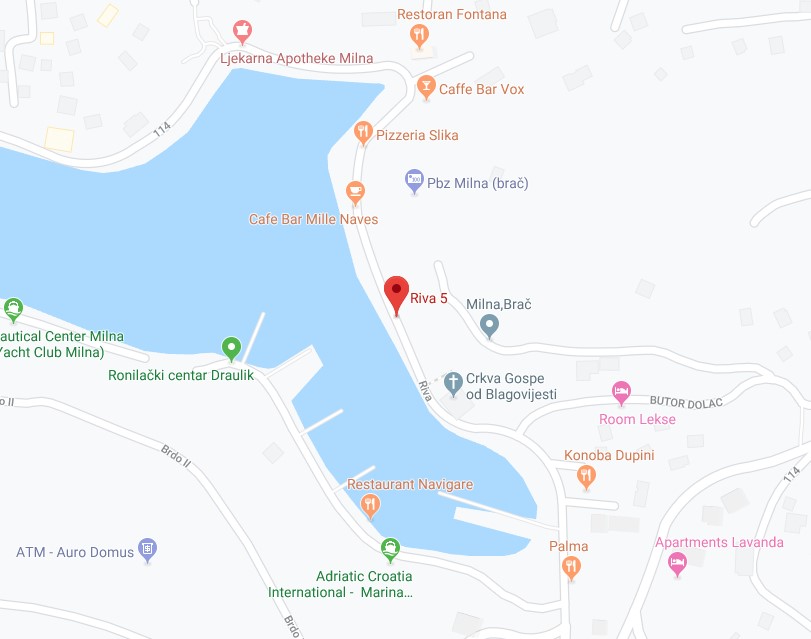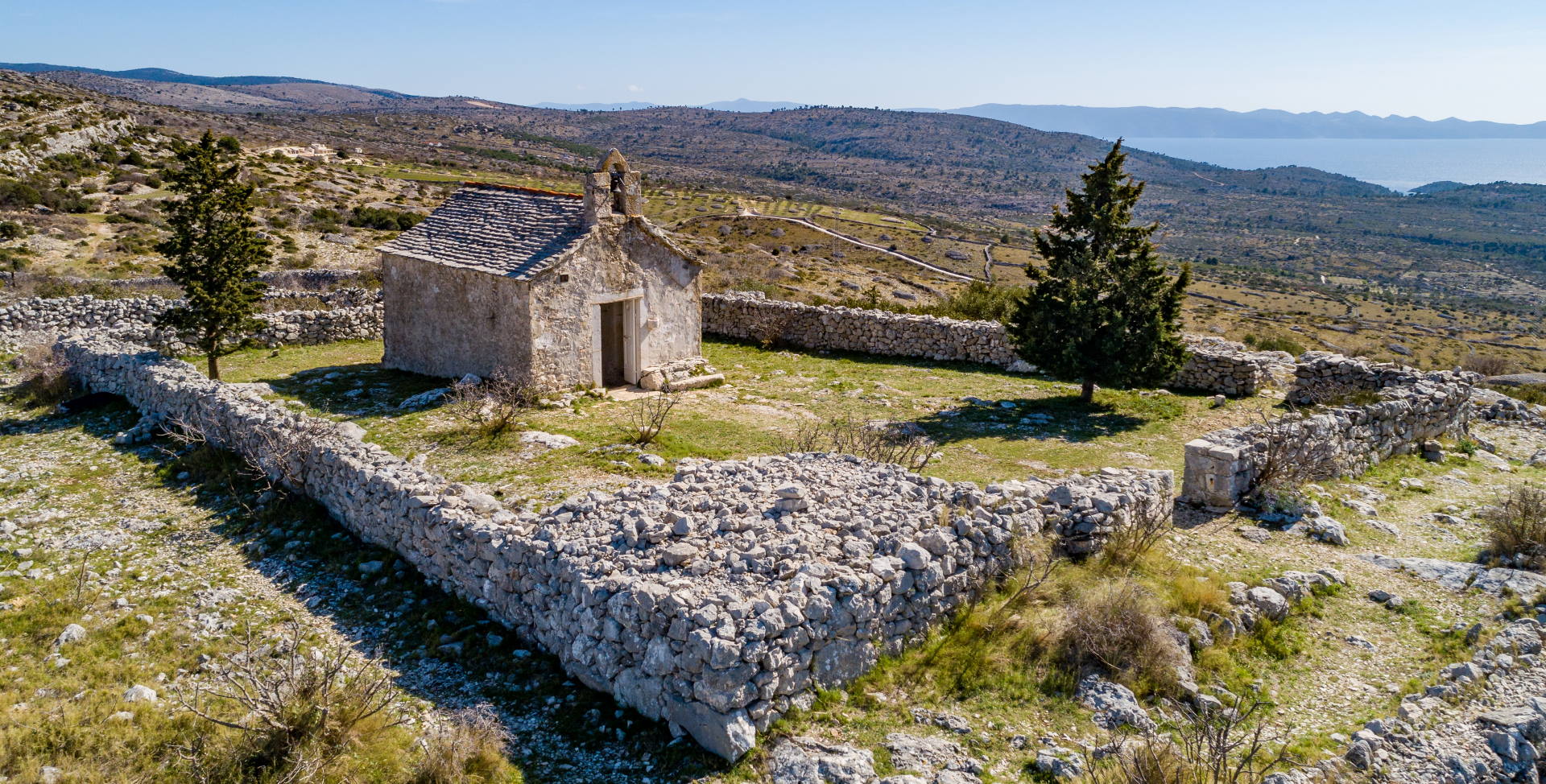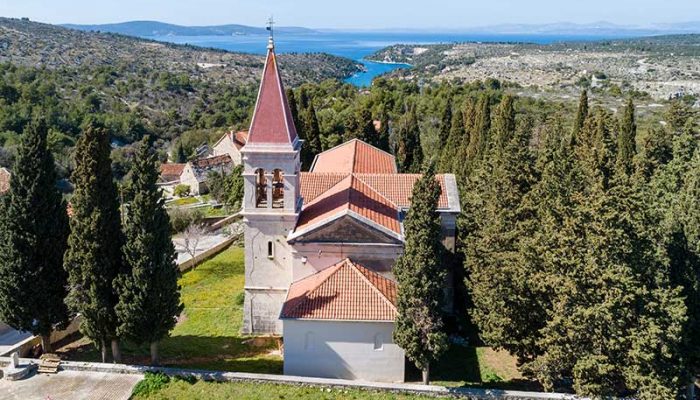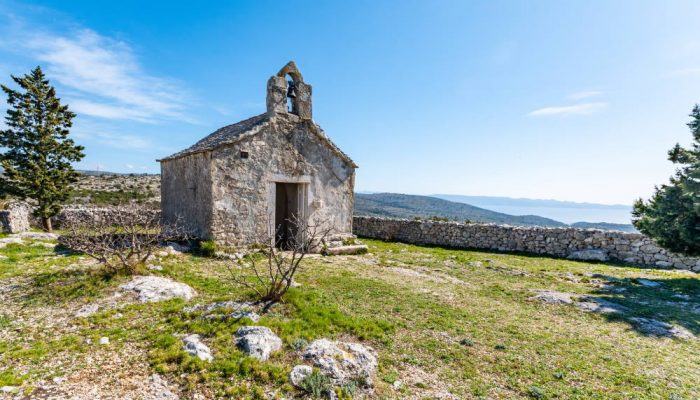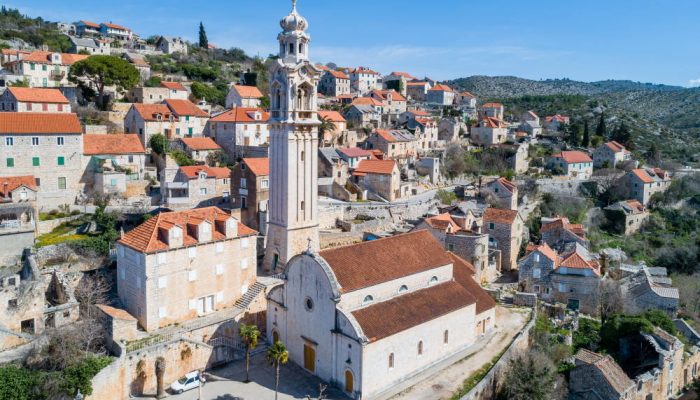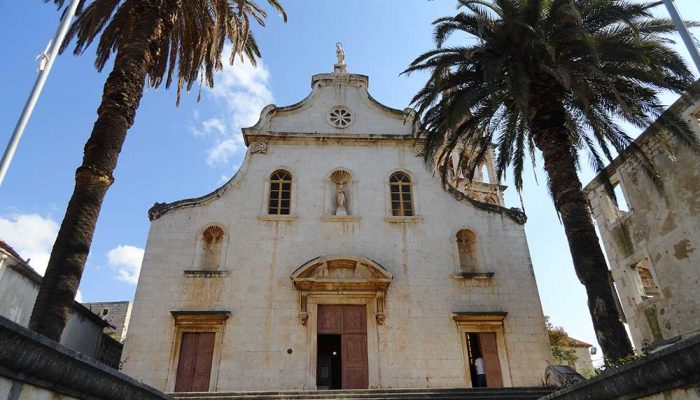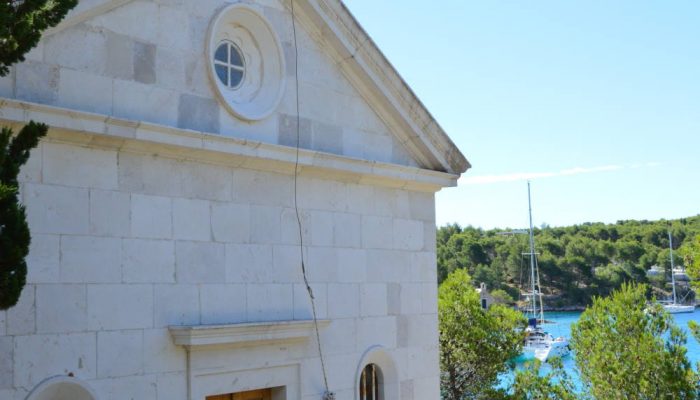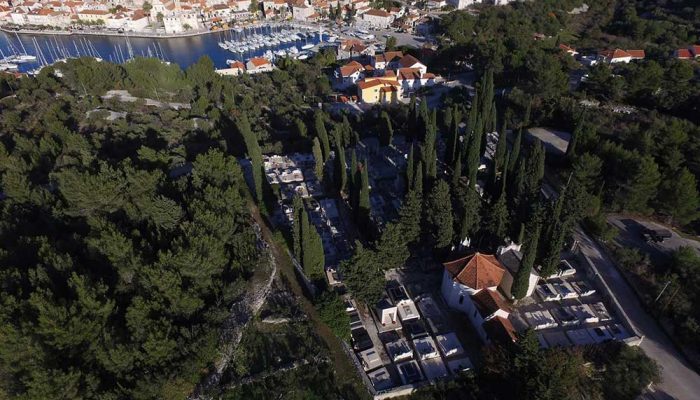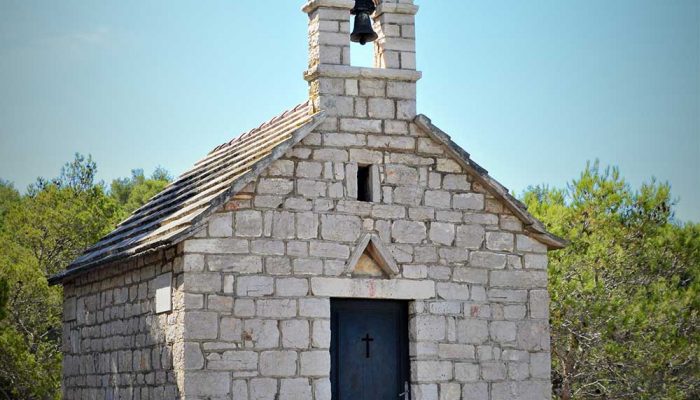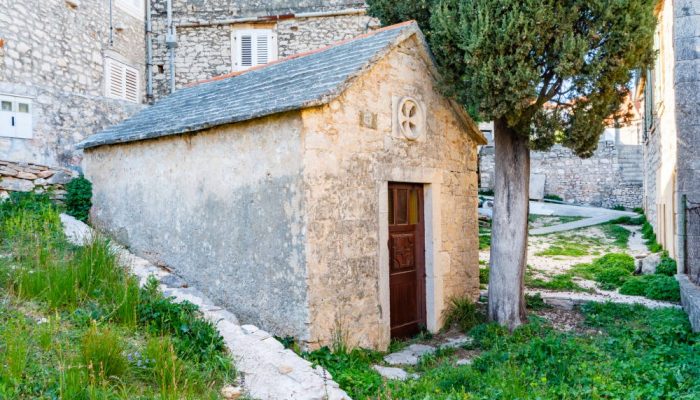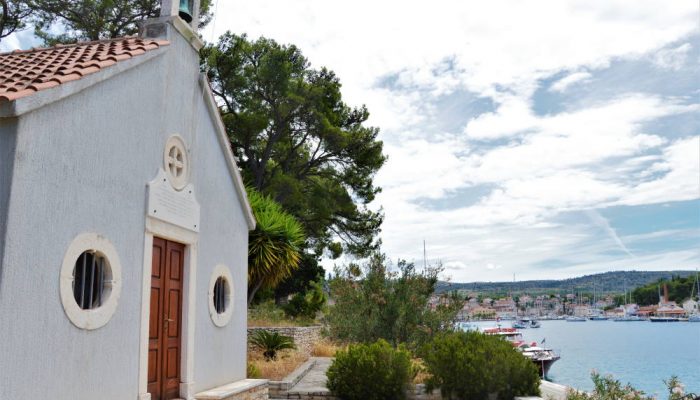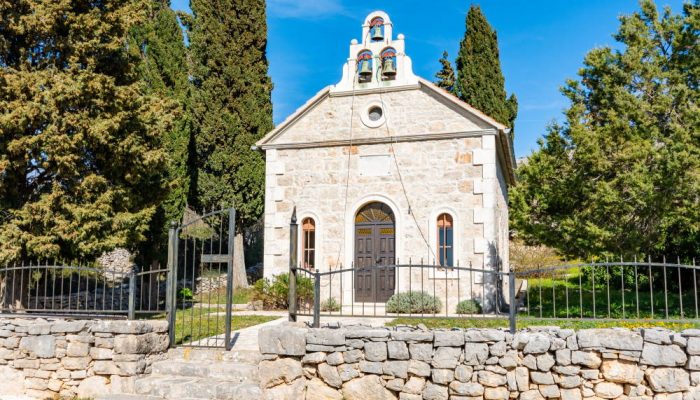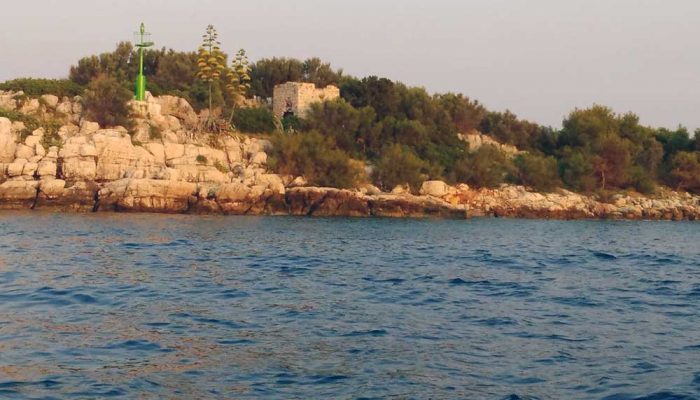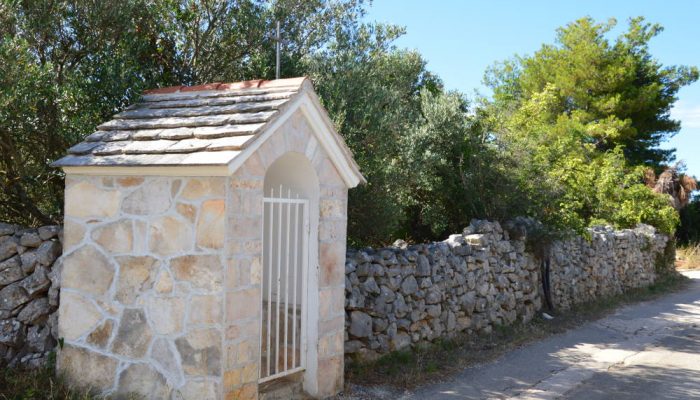Church of St. George (Bobovišća)
The construction of St. George began in 1656 and ended in 1696, as is documented by the inscription on the stone doorpost, found in front of today’s parish church. At the end of the 19th century the old church was torn down and in 1914 a new church was built, which still exists today.
Church of St. Martin (Bobovišća)
Church of St. Martin was built on the hill between Bobovišća and Milna in a strategically important position with the view of the waters from Split Gates to islands Hvar and Vis. This single nave church with a semicircular apse and its proportions and shape embodies the qualities of mature pre-Romanesque design. The simple stone façade at the top has a triangular gable dating from the 14th century. The church features a semicircular ceiling, and the walls are divided by wide shallow niches. Above the altar is a Renaissance stone relief, from the workshop of Niccolo Fiorentino, with the depiction of St. Martin on horseback with a beggar.
Church of St. Martin is a protected cultural heritage of the Republic of Croatia.
Church of St. John and Paul (Ložišća)
Church of Saints John and Paul was built in 1820. It has a baroque façade and a stone court in front of the church. The most prominent part of the church is the ornate bell tower designed by the prominent Croatian sculptor Ivan Rendić and built in 1899.
Ložišća villagers invited the then renowned Brač architect and sculptor to design the new bell tower for their church. Rendić showed up to the meeting with a bag full of various bell tower drawings, most of them simple and ordinary in design.
However, as he was flipping through the drawings, the one depicting today’s bell tower showed up and the locals immediately stopped him: “This is the one we want!”, they said resolutely.
Rendić laughed and said, “You can neither make this bell, nor afford it, this one is meant for Venice.” It was those words that ignited the infamous Dalmatian defiance in them: “Oh, is that right?! You think we can’t? Now you’ll see.” And so in the entire village took out loans that they spent years paying back in wine and olive oil. Nevertheless, they accomplished what they set their minds to.
Church of Our Lady of the Annunciation, Milna
Built in 1783 in Baroque style, the church is adorned with an ornate façade and stone steps leading up to the church. The tall stone bell tower is older than the church itself and was erected in the 16th century. At the top of the upper floor, there are 8 stone mascaron heads on the semicircular arches of the bell tower. What is noteworthy about the parish church is that it was built as a whole – it has not been expanded, built upon or restored, so it is proportionate, harmonious and beautiful. Within the church is the sacristy, the original church of St. Mary, built in 1519, and later beautifully integrated into the parish church by the architect.
The interior of the church has the character of a cathedral, full of light, with seven marble altars carrying valuable paintings, works of Venetian painters. The most valuable are the one attributed to Sebastian Ricca and the second one which depicts the Assumption of Mary, on the back of which is written “Paolo Veronese pixit 1500”. The church also houses an organ made in 1822 by the Callido brothers of Italy.
The Church of Our Lady of the Annunciation is a culturally protected heritage of the Republic of Croatia.
Church of St. Joseph, Osibova Bay
Osibova is a bay south of Milna. This small and quiet double bay offers somewhat odd shelter from the winds and is home to two churches. St. Joseph’s Church is a wide single-nave structure with an extended semicircular apse adorned with classicist style stone elements. The church was built by the Brotherhood of St. Joseph in 1869. The main altar features a 17th century altarpiece with the image of St. Joseph, a donation by the Zadar archbishop Vicko Zmajević.
Our Lady of Seven Sorrows Church and Cemetery
In the early 19th century, under Napoleon’s rule, burial on church grounds and in settlements was prohibited all across Dlamatia. And so in 1880 Milna cemetery was relocated and an octagonal mausoleum-style church dedicated to the Lady of Seven Sorrows was built. Burial of the dead in the newly built cemetery began in 1895. Initially it was enclosed by a plain stone wall, and later a high wall was built in 1898. The cemetery is positioned on an elevation, on the opposite side of the bay, in a way that faces the town and the entrance to the cemetery “is looking at” the entrance to the parish church. Such a position on the high ground, “cross facing a cross”, creates the effect of the holiness and (spiritual) elevation of the last resting place. The position of the cemetery, with its main northern façade overlooking the town and the parish church, is an example of neoclassicist concept of connecting spaces visually and infrastructurally.
Church of St. John the Baptist
Historically and architecturally immensely valuable restored church of Sv. John the Baptist with Gothic elements, used to be simply called the Old Church. It was built in the 14th century in the transition from Romanesque to Gothic architecture. It was renovated in 1994 with the help of Juraj Buzolić from Milna. It holds valuable Baroque reliefs of the renowned sculptor Matko Mijić.
Church of St. Jerome
At the beginning of the Pantera bay were once a shipyard and a slipway owned by Mate Bonačić-Protti, son of late Prosper. In 1860, his son Jere commissioned building a small church in the Banjić area, with the permission of the Archbishop. He dedicated the church to his patron saint, St. Jerome.
Church of St. Nicholas
At the entrance to the harbor of Milna, on the right, there is a church dedicated to St. Nicholas, patron saint of sailors. It was built in 1844 by Arne Harašić, landowner from Milna, for the spiritual needs of the locals and to the great joy of the sailors who were using the Vlaška Bay to shelter from stormy weather.
For several years he urged the bishop, the municipality and the authorities in Supetar to allow him to build a church. He spent over 600 forints on it. He also endowed the church with a piece of land called Platac, with a vineyard and an olive grove. On the Feast of St. Nicholas the church holds a celebration, especially honored by the seamen of Milna.
Church of Our Lady of Lourdes (Podhume)
In their day, Podhume were mostly inhabited by shepherds. In 1898, at their request of the people of Milna, the parish priest petitioned the Bishop of Hvar for permission to build a small church in which God’s service could be performed. The bishop asked for all possible permits, plans and sources of funding. Neither the pastor nor the people could meet these episcopal requirements. The pleadings were repeated several times, but to no avail. In 1925, however, a church was built in honor of Our Lady of Lourdes thanks to the people of Milna and the brothers of the late Mihovil Marangunić. In 1962 the church was consecrated, and since then the locals have been making pilgrimages to Podhume every year on the Feast of Our Lady of Lourdes, February 11th.
Church on the Islet of Mrdulja
On the islet of Mrduja with a diameter of nearly half a kilometre and a height of 9 metres, situated between the islands of Brač and Šolta, there is a mediaeval church with a tower. On the corner of the front of the building, there is a pilaster with an elongated cross engraved on it. The arms of the cross are wider towards the end, and there is a rectangular protrusion in the middle. The church – fort is visible when passing through Split Gate /Splitska vrata/ by boat, and it has been masterfully constructed as a combination of a church and fort. According to its interior and construction of its walls, it has been dated to the Late Renaissance. This church – fort, together with the Baterija fort on Zaglav cape, was of great strategic importance during the 16th and 17th century, the period when fierce battles between the Venetians and Ottomans were waged. After the fall of the Republic of Venice, these forts once again came in handy as a defence from the Russian occupation of Brač in 1807.
Chapels of the The Way of the Cross
Osibova Bay can be reached via a nice two kilometer trail. On the left side of the trail are 14 stone chapels depicting the Stations of the Cross. The chapels were built by the Skarneo family at the end of the 18th century. Milna worshipers often go to the church of St. Joseph and on the way they observe the Way of the Cross.
The Ossuary
The ossuary is located next to the parish church and can be reached through the sacristy. There are two openings, one marked with the year 1833 and a cross, and the other opening is used to ventilate and depose the bones. As it happens, when the church foundations were being repaired due to water damage, under Don Toni Plenković, one piece of doorstep was broken and an opening 4.5 meters deep full of bones was discovered. According to the conservationist that analyzed them, the discovered bones were from the time when the deceased were buried in the churchyard, and were probably taken out in 1805 with the arrival of Napoleon and the French authorities in Dalmatia when burial in the churchyard was prohibited for hygiene reasons.

